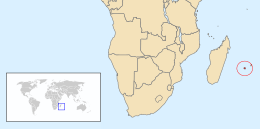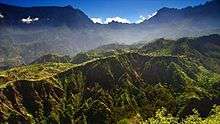Réunion swamphen
| Réunion swamphen | |
|---|---|
 | |
| Hypothetical restoration by John Gerrard Keulemans, 1907 | |
| Scientific classification | |
| Kingdom: | Animalia |
| Phylum: | Chordata |
| Class: | Aves |
| Order: | Gruiformes |
| Family: | Rallidae |
| Genus: | Porphyrio |
| Species: | P. coerulescens |
| Binomial name | |
| Porphyrio coerulescens (Selys, 1848) | |
 | |
| Former range (encircled) | |
| Synonyms | |
|
Apterornis coerulescens Selys, 1848 | |
The Réunion swamphen, Réunion gallinule or oiseau bleu (Porphyrio coerulescens) is a hypothetical species of extinct rail from Réunion, Mascarenes only known from reports of travellers.
Taxonomy

It is quite certain that such a bird once was present on the island. Six reports attest to its existence, and the genus Porphyrio is known as a colonizer of oceanic islands, having evolved into many local endemic species, of which only the takahē is still found to be extant nowadays.
In 1848, Sélys Longchamps placed the Réunion swamphen in the genus Apterornis, wherein he also included the Réunion solitaire and the red rail, but the name was preoccupied by Aptornis, a bird described by Richard Owen in 1844.[2]
In November 1974, it was attempted to find possible fossil localities on the Plaine des Cafres. No caves or other promising locations were found, and it was determined that the attempt to prove the existence of this bird would have to wait pending a more thorough mapping of the area.
Description
The bird was a bit larger than a chicken, or between a purple swamphen and a takahē in size, and of entirely dull blue coloration, with a red beak and feet.
Dubois' description is as follows (translated from French):
Oyseaux bleus: As big as the Solitaires; they have the plumage entirely blue, the beak and the feet red and made like those of fowls; they do not fly at all, but run extremely quickly, so that a dog can hardly catch them; they are very good.[3][4]
Extinction

The bird is attested to have exclusively occurred on the Plaine des Cafres, the high plateau of Réunion between the Piton des Neiges and the Piton de la Fournaise, from 1700 on at least (Dubois gives no locality information, but all other authors restrict the bird to the plateau). The missionary Père Brown's testimony of 1724 is generally believed to be the last unequivocal record of the bird, but an anonymous British naval officer reports stories about birds limited to the high plateau that can be killed with sticks in 1763.
The various reports disagree about whether this bird was considered good eating; most species of Porphyrio are generally considered to have a rather disagreeable taste. Especially in the light of Jean Feuilley's 1705 report, it seems that adult birds were not usually hunted at least part of the year. This, and the remoteness of its habitat, perhaps explains why the birds were able to persist for longer than most other Réunion endemics, which were extinct by 1700. Since the 1763 report is very unspecific and could as well refer to petrels or shearwaters, it is generally assumed that the Réunion swamphen was extinct by 1730. As the area where it occurred was not yet being cleared for cultivation, introduced predators and hunting by escaped slaves who took to the mountains are probably the reasons for its disappearance.
References
- ↑ BirdLife International (2014). "Porphyrio coerulescens". IUCN Red List of Threatened Species. Version 2014.3. International Union for Conservation of Nature. Retrieved April 20, 2015.
- ↑ Olson, S. (1977). "A synopsis on the fossil Rallidae". In Sidney Dillon Ripley. Rails of the World – A Monograph of the Family Rallidae. Boston: Codline. pp. 357–363. ISBN 0-87474-804-6.
- ↑ Rothschild, W. (1907). Extinct Birds. London: Hutchinson & Co. p. 145.
- ↑ Dubois, D. B (1674). Les voyages faits par le sieur D. B. aux Isles Dauphine ou Madagascar, et Bourbon, ou Mascarenne, és années 1669, 70, 71 et 72. Dans laquelle il est curieusement traité du Cap Vert, de la ville de Surate, des isles de Sainte Helene, ou de l´Ascention. Ensemble les moeurs, religions, forces, gouvernemens et coutumes des habitans des dites isles, avec l´histoire naturelle du pais (in French). Paris: Chez Claude Barbin. pp. 170–171.
- de Sélys Longchamps, Edmond (1848): Résumé concernant les oiseaux brévipennes mentionnés dans l'ouvrage de M. Strickland sur le Dodo. Rev. Zool. 1848: 292-295. [Article in French]
